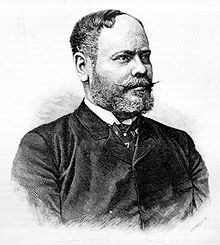Gábor Baross
Gábor Baross von Bellus (born July 6, 1848 in Pružina , † May 9, 1892 in Budapest , Austria-Hungary ) was a Hungarian statesman , economic and transport politician of the dual monarchy and founder of modern transport and trade in Hungary.
Live and act
Baross was born in Pružina near Trencsén on July 6, 1848. He was the son of the judge Anton Baross (* 1819, † 1894) and his wife Natalia Maria Theodora born. by Pongrác (* 1825, † 1916). He completed his secondary schools in Léva and in the Benedictine grammar school in Esztergom (from 1861 to 1865). He attended the Faculty of Law, University in Pest and was after their statements as Komitatsbeamten in his home Trencsén. In 1875 he was elected as a member of the Hungarian Diet . In the political life of Hungary he became an advocate of the politics of Kálmán Tisza . In 1878 he was elected notary public in the Reichstag and in 1883 he was state secretary in the Ministry of Transport and Labor. He quickly became one of the most important pillars in this field of politics, so he was appointed Minister of this portfolio in 1886 and took over the Ministry of Commerce three years later. He held this post until his death.
Baross saw the regulation of the lower Danube valley as one of his most important tasks . In 1878, at the Berlin Congress Austria-Hungary was given the task of regulating the Danube at the Iron Gate . However, Baross could not see the completion of the work, it did not happen until 1896. In addition to this project, the development of communication channels, especially the railway network, was of particular importance to Baross at that time . He combined this with the further development of the postal system and telegraphy . In 1890 the first telephone line was put into operation between Vienna and Budapest . Between 1886 and 1889 the port of Fiume was significantly expanded on his intention .
As Minister of Commerce, he supported the development of Hungarian industry : his policy was aimed at ensuring that state-owned companies should have their needs supplied by Hungarian suppliers. More than 100 company start-ups are associated with his name. He also supported the development of the chambers of industry and commerce in Hungary and founded the Hungarian Transport Museum .
Gábor Baross died on May 9, 1892 as a result of pneumonia in Budapest at the age of 44. According to his life history, he contracted pneumonia while overseeing the work on the Iron Gate. His remains were transferred to his place of residence in Klobusicz and buried in a mausoleum at the local cemetery.
Afterlife
Baross was buried at the expense of the Kingdom of Hungary in a mausoleum in Klobusicz, near Ilava in the Waag Valley.
Twelve streets and squares were named after him in Budapest, and there are also paths named after him in Győr , Zalaegerszeg and Mohács .
His hometown Pružina bore the Hungarian name Barossháza after his death .
Dozens of elementary and technical schools in today's Hungary bear his name, and the Hungarian State Railways have a training center named after Baross. The Hungarian Research and Technology Office has also named its research and development infrastructure development program after Gábor Baross. In addition, a Baross Gábor Society for National Economic Development, founded by Hungarian intellectuals , has existed since 2003 .
literature
- Frisnyák Zsuzsa (Ed.): Baross Gábor. Dinasztia Kiadó, Budapest 2000, ISBN 963-657-343-3 .
- Péter Hanák: Hungary in the Danube Monarchy. Problems of the bourgeois transformation of a multi-ethnic state. Verlag für Geschichte u. Politics, Vienna 1984, ISBN 3-7028-0202-9 .
Web links
- Encyclopaedia Britannica 1911
- Entry about Gábor Baross in the Hungarian Biographical Lexicon (MEK) of the National Széchényi Library (Hungarian)
- Large Pallas Lexicon
- História 1992/08 Frisnyák, Zsuzsa: A vasminiszter. / The Minister of Steel./
- Austrian Biographical Lexicon
- Baross Mausoleum (Slovak)
Individual evidence
- ↑ clothes. Pruzsina, was 1899 in Barossháza, Trencsén County , renamed.
- ↑ Klobusicz (Slov. Klobušice ) was incorporated into Illau (Slov. Ilava) in 1971 as part of a territorial reform .
- ↑ Baross Gábor Oktatási Központ accessed on July 3, 2018 (Hungarian)
| personal data | |
|---|---|
| SURNAME | Baross, Gábor |
| BRIEF DESCRIPTION | Hungarian politician |
| DATE OF BIRTH | July 6, 1848 |
| PLACE OF BIRTH | Pružina , Hungary |
| DATE OF DEATH | May 9, 1892 |
| Place of death | Budapest , Hungary |


